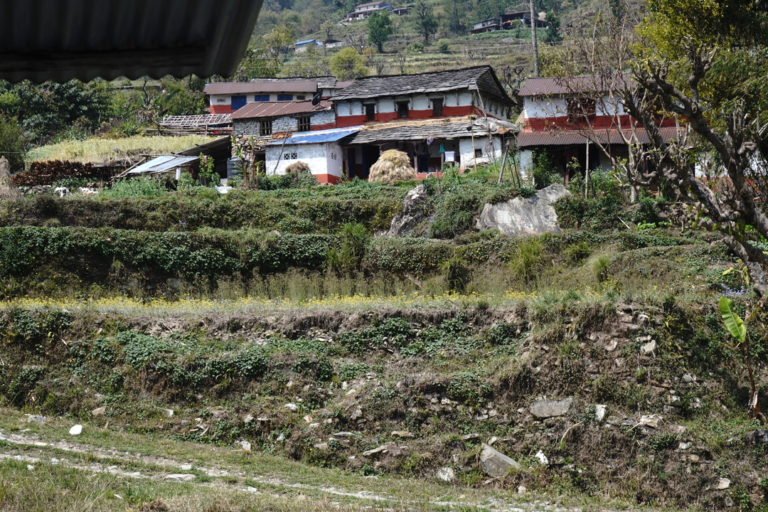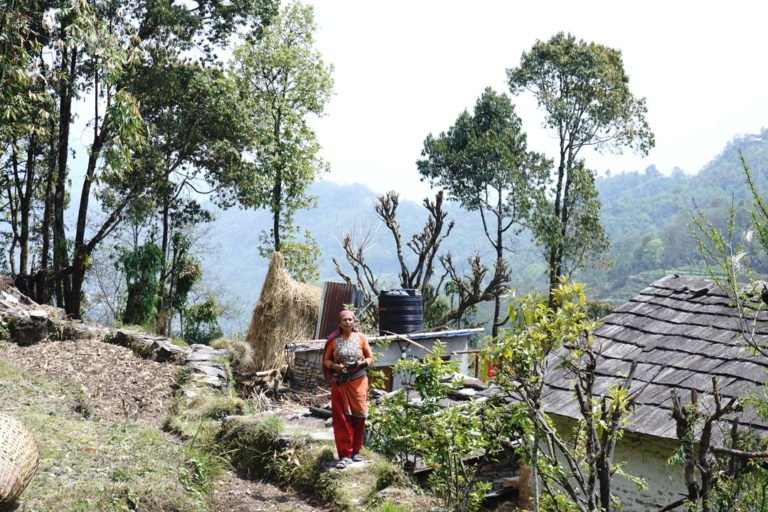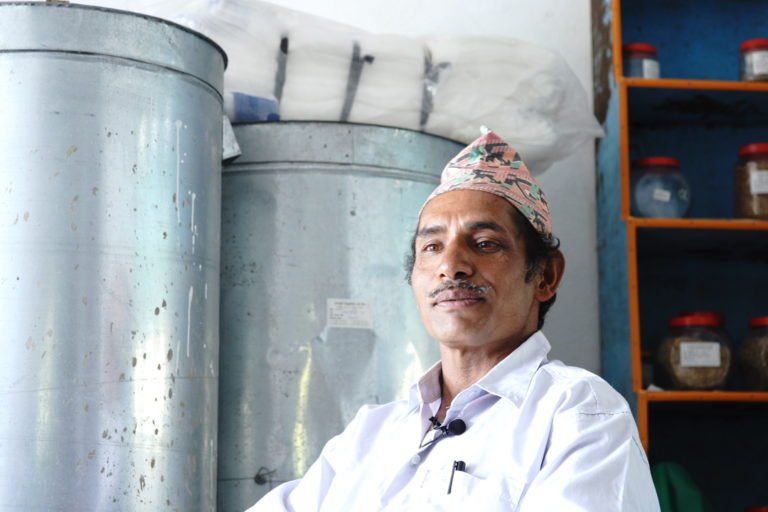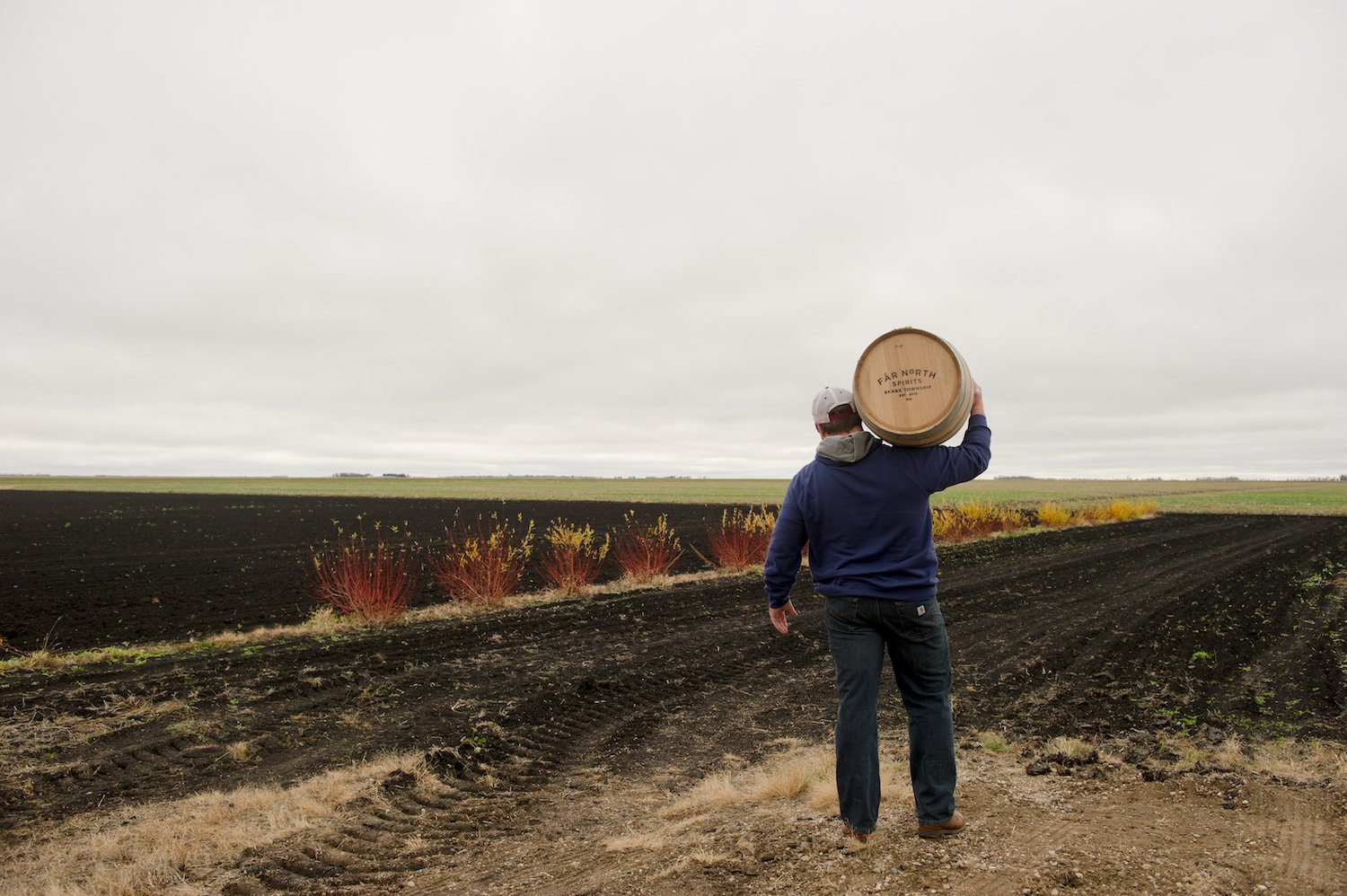- A grassroots movement to revive native varieties of food crops is gaining support in Nepal with the establishment of seed banks across the country.
- Proponents say they hope to nurture seeds that are more resistant to the impacts that Nepal is already seeing from climate change.
- Nepal imports most of its crop seeds, including hybrid varieties; these include 90% of vegetable seeds, nearly 30% of maize seeds, and 15% of rice seeds.
MARAMCHE, NEPAL— The monsoon clouds that arrive in Nepal in the first week of June herald the start of the rice-planting season. The country’s hills, valleys and plains turn green as farmers take to their muddy fields to start sowing the crop that will feed them for the whole year.
As most farmers turn to the market for seeds they hope will give them the maximum yield, Krishna Prasad Adhikari and other residents of the village of Maramche in Gandaki province, western Nepal, are opting for a variety that won’t necessarily do that. They’ve settled on a native rice variety well suited for the high altitude and wet climate.
“We are trying to save our heritage,” says Adhikari, secretary of the Maramche Community Seed Bank, established in 2020 to conserve local 12 varieties of crops that include rice, cucumbers and maize.
“We have understood the importance of saving local varieties for future generations,” Adhikari says. Among the crops, he takes particular pride in the cold-resistant variety of rice.
Until three years ago, Adhikari and his neighbors didn’t know that saving local varieties was important. Things changed when Adhikari got the opportunity to attend a meeting of Nepal’s national association of community seed banks in Kathmandu. It was here that he understood the importance of native seeds and crops, and decided to join the movement, already in its 25th year. The farmers learned that these varieties were not only tolerant to extreme weather and pests, but the conservation of their genetic resources could also be used for the development of new varieties resistant to the effects of climate change.
“When I returned home, I shared what I had learnt with my neighbors and we decided to set up our own community seed bank that would be run by our already existing cooperative,” Adhikari tells Mongabay.
Previously, the community bought seeds from the market, often sold in loose packets, Adhikari says. There was no guarantee that it was the seed of the crop it claimed to be. At times, when the villagers planted what they thought were radish seeds, the roots never developed. Or another legume or grain would sprout up instead of what was advertised.
According to agronomists, this is to be expected, given that more than 90% of vegetable seeds used in Nepal are imported. Nearly 30% of maize seeds and 15% of rice seeds are also derived from other countries. Different varieties of vegetables and crops traditionally grown in Nepal have been lost as farmers shifted to improved seeds. The exact number of varieties lost is not yet known.
For example, the cucumber variety that’s native to Maramche village is shaped like the madal, a traditional Nepali folk music instrument. A native variety of rice is black, in stark contrast to the white varieties available in the market.
Farmers in Nepal’s hills used to keep their traditional seeds to sow during the next season. When the same seed is used generation after generation, through refinement, diversity thrives. But in the case of Nepal, an entire generation of farmers abandoned the profession in the 1990s to move to urban areas in search of better opportunities for themselves and their families.
Dozens of community seed banks
According to the Nepali government’s Centre for Crop Development and Agro Bio-diversity Conservation, there are currently 53 entities that could be classified as community-run seed banks across Nepal.
A typical seed bank has members who use the seeds to grow crops year after year and save them for future use, says Pitambar Shrestha from the NGO Local Initiatives for Biodiversity, Research and Development (LI-BIRD). The organization has helped establish 25 community seed banks across the country and guides communities in meeting their objectives.
“A seed bank is a living bank of seeds that the farmers utilize regularly and return to it again for the next season,” Shrestha says.

It wasn’t just problems associated with hybrid seeds that led the community to start the seed bank.
“We also realized other benefits of conserving native species,” says Jamuna Adhikari, a member of the cooperative. “For example, the native species re more tolerant to extreme weather and pests compared to non-native ones.” In Maramche, the native rice species can tolerate the cold and wet weather of the hills.
“Also, conserving genetic resources is vital for the development of new varieties that can withstand changes in the climate,” Jamuna, who lives in the same village as Krishna Adhikari, tells Mongabay. “Native species are always good at surviving extreme weather events caused by climate change.”
Community seed banks also participates in regular seed exchange programs organized by the national association. “The exchange programs help farmers get seeds from other farmers and conserve native species,” Shrestha says. “The exchanges take place not only under customary rights of the farmers, but also under international law,” he adds, citing the International Treaty on Plant Genetic Resources for Food and Agriculture.
The national seed bank association, with technical support from LI-BIRD also has an Android app through which farmers and their organizations can exchange information about native varieties of seeds.
In addition to participating in exchanges, the cooperative sells seeds certified by local government agencies. A seed producer needs to get each batch certified by the government before it can be sold in the market.
Challenges getting seed banks on their feet
Despite the success in saving some native varieties, the seed banks across Nepal face a host of challenges, Shrestha says. The mass migration of young population to cities in Nepal and abroad means that the zeal and enthusiasm to keep the seed banks running may run out among future generations.
“The government has also not yet provided a procedure to register these community seed banks, which these days need to register as cooperatives or NGOs to do their work,” Pitambar Shrestha tells Mongabay.
The other issue is that the seed banks need sustained financial support for seven to eight years before they can stand on their own feet, Shrestha says. This support is especially required to market the products based on native species. For example, a native quinoa variety from Lamjung district and a red rice variety from Jumla district have had some commercial success due to their unique taste and nutritious nature, Shrestha says. In Maramche, both the supporting organizations and the community are yet to figure out how to market the native variety of rice they produce.

Although many NGOs working in Nepal are trying to emulate the community seed bank model, they fail to fully understand the issues at work, Shrestha says.
“They just collect seeds in a bottle and place them in a room, which they call a seed bank,” he says. “That doesn’t work as it doesn’t follow the norms we have laid out for seed banks.”
Rakshya Shah, senior livelihoods manager at the Nepal office of the IUCN, the global plant and wildlife conservation authority, says municipal authorities need to step up to help these seed banks sustain, survive and prosper.
“We need the municipal authorities to register them and provide the support,” Shah says. The community seed banks can’t run on their own for a long time, she adds, and the central government also needs to come up with policies to facilitate the activities of community-run seed banks.
Such policies were introduced, on paper, in 2009, when the government announced it would register community seed banks and provide them with support such as funding and expert advice.
“However, the policies were not practical, especially with regard to the technicalities such as number of seeds, farmers and available resources,” Shrestha says.

Back in Maramche, Krishna Adhikari continues to work on his farm, despite the hovering clouds of uncertainty over marketing his produce and the success of his endeavors.
“We know we are playing our part in the conservation of our heritage,” he says. “That’s what matters for now.”
Banner Image: Nepali farmer Krishna Adhikari at his community’s seed bank in Maramche, Kaski. Image by Bhabishya Paudel
Feedback: Use this form to send a message to the author of this post. If you want to post a public comment, you can do that at the bottom of the page.














